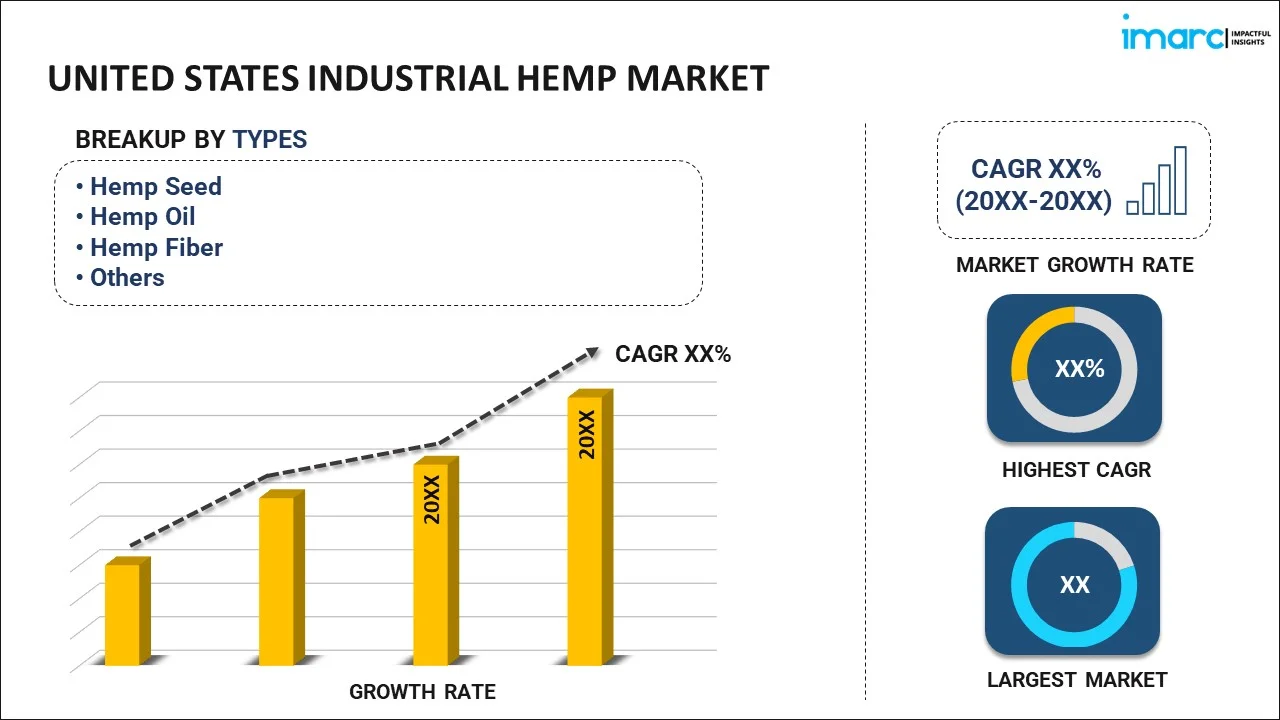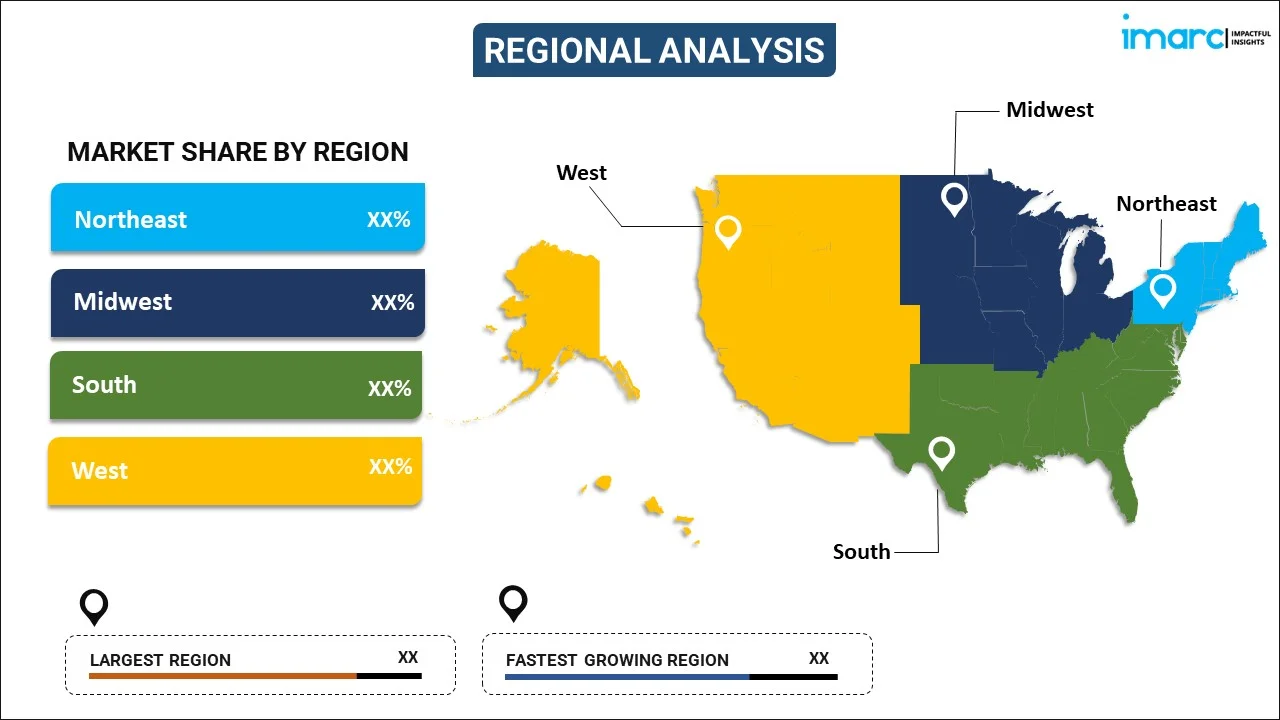
United States Industrial Hemp Market Report by Type (Hemp Seed, Hemp Oil, Hemp Fiber, and Others), Source (Conventional, Organic), Application (Food and Beverages, Textiles, Personal Care Products, Pharmaceuticals, and Others), and Region 2025-2033
Market Overview:
United States industrial hemp market size reached USD 1.6 Billion in 2024. Looking forward, IMARC Group expects the market to reach USD 8.7 Billion by 2033, exhibiting a growth rate (CAGR) of 20.1% during 2025-2033. The growing demand for breathable and comfortable clothing options, increasing focus on maintaining a healthy lifestyle among people, and rising need to mitigate greenhouse gas (GHG) emissions and combat climate change represent some of the key factors driving the market.
|
Report Attribute
|
Key Statistics
|
|---|---|
|
Base Year
|
2024
|
|
Forecast Years
|
2025-2033
|
|
Historical Years
|
2019-2024
|
|
Market Size in 2024
|
USD 1.6 Billion |
|
Market Forecast in 2033
|
USD 8.7 Billion |
| Market Growth Rate 2025-2033 | 20.1% |
Industrial hemp is a variety of the Cannabis sativa plant species that contain minimal levels of tetrahydrocannabinol (THC). It is known for its favorable fatty acid profile, which makes it a suitable choice in dietary supplements. It has eco-friendly characteristics and can be grown without the need for several synthetic fertilizers while requiring less water. It can remediate contaminated soils by absorbing heavy metals and other pollutants. It can also improve the soil quality for future crops through phytoremediation and remove contaminants efficiently. It absorbs carbon dioxide from the atmosphere, which makes it a potential contributor to carbon sequestration efforts. It assists in reducing the risk of heart disease and promoting healthy cholesterol levels. As it aids in managing chronic pain and alleviating symptoms of anxiety and stress, the demand for industrial hemp is rising in the United States.
United States Industrial Hemp Market Trends:
The increasing adoption of industrial hemp in the textile sector to provide breathable and comfortable clothing experiences to users currently represents one of the primary factors supporting the market growth in the United States. In line with this, the escalating demand for hemp seeds in the food and beverage (F&B) sector, as they are rich in protein, essential fatty acids, vitamins, and minerals, is positively influencing the market in the country. Additionally, the rising employment of industrial hemp to produce biofuels, such as biodiesel and ethanol, is impelling the growth of the market in the US. Apart from this, there is an increase in the need for industrial hemp for paper production. This, coupled with the rising use of industrial hemp to make hempcrete, a sustainable building material that is lighter and more eco-friendly as compared to traditional concrete, is strengthening the market growth in the country. Besides this, the increasing adoption of industrial hemp in crop rotation systems to improve soil health and reduce the need for synthetic fertilizers while promoting regenerative farming practices is propelling the market growth. In addition, the rising utilization of industrial hemp in bioplastic production to reduce the environmental impact of plastic products is offering lucrative growth opportunities to industry investors. Furthermore, the growing demand for hemp-derived cannabidiol (CBD) in various health and wellness products, such as oils and tinctures, along with the increasing focus on maintaining a healthy lifestyle among individuals, is offering a positive market outlook in the country. The rising cultivation of industrial hemp plants to mitigate greenhouse gas (GHG) emissions and combat climate change is also bolstering the market growth in the US.
United States Industrial Hemp Market Segmentation:
IMARC Group provides an analysis of the key trends in each segment of the market, along with forecasts at the country level for 2025-2033. Our report has categorized the market based on type, source, and application.
Type Insights:

- Hemp Seed
- Hemp Oil
- Hemp Fiber
- Others
The report has provided a detailed breakup and analysis of the market based on the type. This includes hemp seed, hemp oil, hemp fiber, and others.
Source Insights:
- Conventional
- Organic
A detailed breakup and analysis of the market based on the source have also been provided in the report. This includes conventional and organic.
Application Insights:
- Food and Beverages
- Textiles
- Personal Care Products
- Pharmaceuticals
- Others
The report has provided a detailed breakup and analysis of the market based on the application. This includes food and beverages, textiles, personal care products, pharmaceuticals, and others.
Regional Insights:

- Northeast
- Midwest
- South
- West
The report has also provided a comprehensive analysis of all the major regional markets, which include Northeast, Midwest, South, and West.
Competitive Landscape:
The market research report has also provided a comprehensive analysis of the competitive landscape. Competitive analysis such as market structure, key player positioning, top winning strategies, competitive dashboard, and company evaluation quadrant has been covered in the report. Also, detailed profiles of all major companies have been provided.
United States Industrial Hemp Market Report Coverage:
| Report Features | Details |
|---|---|
| Base Year of the Analysis | 2024 |
| Historical Period | 2019-2024 |
| Forecast Period | 2025-2033 |
| Units | Billion USD |
| Scope of the Report | Exploration of Historical and Forecast Trends, Industry Catalysts and Challenges, Segment-Wise Historical and Predictive Market Assessment:
|
| Types Covered | Hemp Seed, Hemp Oil, Hemp Fiber, Others |
| Sources Covered | Conventional, Organic |
| Applications Covered | Food and Beverages, Textiles, Personal Care Products, Pharmaceuticals, Others |
| Regions Covered | Northeast, Midwest, South, West |
| Customization Scope | 10% Free Customization |
| Post-Sale Analyst Support | 10-12 Weeks |
| Delivery Format | PDF and Excel through Email (We can also provide the editable version of the report in PPT/Word format on special request) |
Key Questions Answered in This Report:
- How has the United States industrial hemp market performed so far and how will it perform in the coming years?
- What has been the impact of COVID-19 on the United States industrial hemp market?
- What is the breakup of the United States industrial hemp market on the basis of type?
- What is the breakup of the United States industrial hemp market on the basis of source?
- What is the breakup of the United States industrial hemp market on the basis of application?
- What are the various stages in the value chain of the United States industrial hemp market?
- What are the key driving factors and challenges in the United States industrial hemp?
- What is the structure of the United States industrial hemp market and who are the key players?
- What is the degree of competition in the United States industrial hemp market?
Key Benefits for Stakeholders:
- IMARC’s industry report offers a comprehensive quantitative analysis of various market segments, historical and current market trends, market forecasts, and dynamics of the United States industrial hemp market from 2019-2033.
- The research report provides the latest information on the market drivers, challenges, and opportunities in the United States industrial hemp market.
- Porter's five forces analysis assist stakeholders in assessing the impact of new entrants, competitive rivalry, supplier power, buyer power, and the threat of substitution. It helps stakeholders to analyze the level of competition within the United States industrial hemp industry and its attractiveness.
- Competitive landscape allows stakeholders to understand their competitive environment and provides an insight into the current positions of key players in the market.
Need more help?
- Speak to our experienced analysts for insights on the current market scenarios.
- Include additional segments and countries to customize the report as per your requirement.
- Gain an unparalleled competitive advantage in your domain by understanding how to utilize the report and positively impacting your operations and revenue.
- For further assistance, please connect with our analysts.
 Request Customization
Request Customization
 Speak to an Analyst
Speak to an Analyst
 Request Brochure
Request Brochure
 Inquire Before Buying
Inquire Before Buying




.webp)




.webp)












